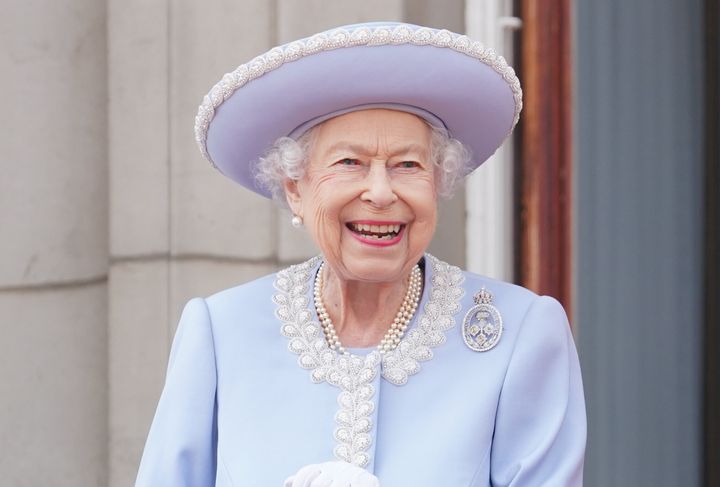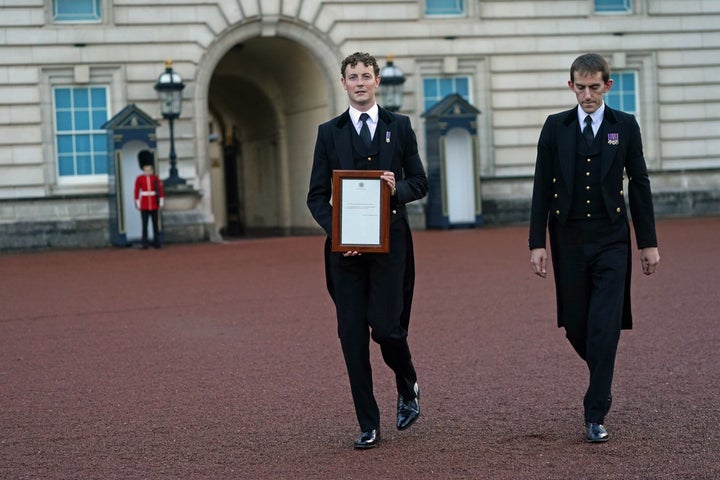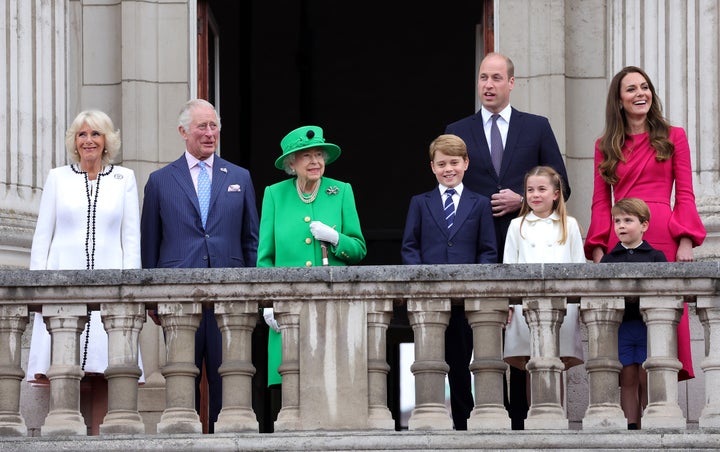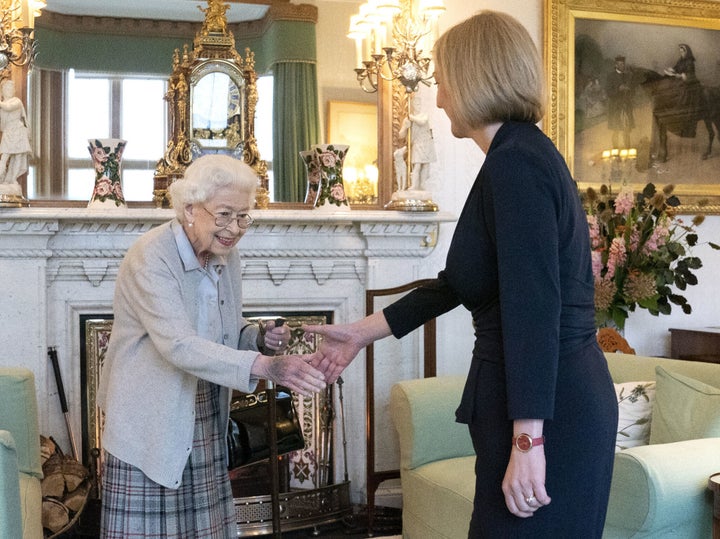
Buckingham Palace confirmed that the Queen has died, aged 96, at her Scottish residence of Balmoral on Thursday afternoon.
Her death marks the end of an era, and has sent shockwaves across the nation, while condolences stream in from across the world.
Prime minister Liz Truss was one of the first to publicly acknowledge that a new reign began yesterday – that of the Queen’s eldest son, King Charles III.
Here’s what will happen next.
What happened when the news broke?
According to The Guardian’s break down of “Operation London Bridge” – the supposed code name for this occasion, which has been in place since the 1960s – the first thing that would have happened was the Queen’s private secretary, Sir Edward Young, contacted the prime minster.
The news then would reportedly have gone out to the 56 nations of the Commonwealth, including the 13 governments outside the UK where the British monarch is also head of state.
Flags at royal residences went to half-mast when the news of her death broke. They will remain so until 8am the morning after the final day of royal mourning.
The Queen’s body will initially lie at Balmoral, where she died, before being carried up to Royal Mile to St Giles’ Cathedral.
She will then board the Royal Train at Waverley station down the east coast of the country, and the general public may throw flowers to mark her passing.
Once she arrives in London, her body will then be placed in the throne room of Buckingham Palace, while four Grenadier Guards stand watch.
Expect church bells to ring across the country, with one toll for each of the monarch’s life.

London Bridge suggests both the House of Commons and the House of Lords will sit in parliament within hours of her death, to pay their respects. Their tributes will go into Friday evening, while a memorial service at St Paul’s Cathedral is set to take place around the same time.
Charles is also going to address the nation on Friday, at 6pm.
On Saturday, at 10am, there will be a proclamation that he has become King Charles III, while his second wife Camilla, Duchess of Cornwall, will become his Queen Consort. This event held in St Jame’s Palace in front of the Accession Council, for which there will be 700 invited guests, according to the BBC, where officials will swear allegiance to the new monarch.
The proclamation is then signed by the prime minister, Archbishop of Canterbury and lord chancellor.
At a second meeting with the Accession Council, Charles will then carry out his first official duties and swear to protect the Church in Scotland.
More proclamations will continue from various officials, while a 41-gun salute (meaning almost seven minutes of fire) will start in Hyde Park at 1pm on Friday.
A public proclamation declaring Charles as the new King will be made from the a balcony in St James’s Palace by an official called the Garter King of Arms.
Similar announcements will be made in Edinburgh, Cardiff and Belfast.
The national anthem – with the new words ‘God Save The King’ – will play.
What happens before the funeral?
There is expected to be a ceremony in St Paul’s Cathedral the day after her death, while her family members in Balmoral may go to church to honour her passing.
Four days after the day of her death, her coffin will be moved from Buckingham Palace to Westminster Hall where her body will lie in state for another four days.
This transition will be marked with a procession from Buckingham Palace – a great military parade which marches down the Mall, through Horse Guards and past the Cenotaph – a journey which will accommodate around a million people.
There’s been speculation that corgis, the dog breed the Queen looked after throughout her entire reign, will be part of this parade, too.
The procession will reach Westminster Hall on the hour, where the doors will be left open for the public to say goodbye for the next few days, while guards stand by and crown jewels sit on the coffin.
In between her death and the funeral will likely be declared a period of national mourning. It will start on Friday, and is set to last for 10 days. The government has issued guidance explaining how the public and businesses may chose to mark the Queen’s passing, although there is no expectation for anyone to behave in a certain way.
European royal families will come to the UK too, to show their respects and to attend the funeral. They will be put up at Buckingham Palace.
The Royal Family will observe a period of royal mourning from the day of her death until seven days after her funeral. This will be observed by official royals, their staff, troops committed to ceremonial duties and representatives of the royal household on official duties.
What happens at the funeral?
The Queen’s funeral will most likely be held nine days after the day of her death, although the details are still yet to be confirmed.
It’s likely to be a day off for the nation, with shops probably swapping to bank holiday hours and the stock market closing.
She will be the first British monarch to have her funeral in Westminster Abbey since 1760, and 2,000 guests will sit within.
Before dawn on the day of the funeral, the crown, the sceptre and the orb will be removed and cleaned.
Big Ben will strike at 9am, and the coffin will reach abbey doors at 11am when there will be a national silence.
The hearse will travel 23 miles by road to Windsor Castle, where most British sovereigns lie, and then cameras stop broadcasting – her successor, Charles, will drop red earth on the coffin.
She will be buried in a lead-lined coffin, in King George VI’s memorial chapel, and her late husband Prince Philip (who died last April) will be moved from his current resting place in the Royal Vault (also in St George’s Chapel) to join her.
The entire funeral will be overseen by the Earl Marshal, the 18th Duke of Norfolk. He is the most senior peer in the peerage of England.
Many of the extra details at this point have to be signed off by either Charles, or the Duke of Norfolk.

What does this mean for the monarchy?
In terms of royal history, this is a big deal especially as the vast majority of the population only know having Queen Elizabeth II sitting on the throne.
The Queen is the longest reigning monarch in British history, after serving on the throne for more than 70 years. She celebrated those seven decades in June this year while the whole country enjoyed a bank holiday in honour of her Platinum Jubilee.
She also had the second-longest reign in the world’s history, coming closely behind French King Louis XIV who was the the monarch for more than 72 years.
Charles, who was the Queen’s heir apparent, took over automatically upon his mother’s death.
However, there is usually a substantial delay before the deceased’s successor is officially crowned in a lavish coronation, out of both respect for the dead and because of the need to prepare for the extensive celebrations. The Queen ascended the throne on February 6, 1952 after her father King George VI died, but her coronation did not take place until June 2, 1953.
It’s likely to be an Anglican religious service, where at one point the Archbishop of Canterbury will put the solid gold St Edward’s Crown on the new King’s head.
It is a state occasion, and the government will be paying for it and deciding who can be invited. Charles will make the coronation oath, and receive the famous orb and sceptre as part of his new job.
With Charles becoming King, the whole royal line of succession moves up one place. So, Prince William will become the heir apparent, and likely inherit the title of Prince of Wales.
Charles will officially become head of the Commonwealth, too.
The second-in-line to the throne will be his nine-year-old son, Prince George.
According to Operation London Bridge, Charles will then undertake a four-nation tour and a “diplomatic assembling in London not seen since the death of Winston Churchill in 1965”.
All royal residences will be closed until after the Queen’s funeral, along with her private estates.
Does this affect the government at all?
In the long-term, no. The Queen has already appointed the cabinet, meaning there is not a problem around not having a government, although MPs may begin swearing an oath of allegiance to the new sovereign.
In the immediate aftermath of her death, in the House of Lords, two thrones will be replaced by a single chair and a cushion with the golden outline of a crown.
Parliamentary activity will probably be halted, too.
During her final days on the throne, the monarch officially accepted the resignation of former prime minister Boris Johnson and welcomed his successor, Liz Truss, in Balmoral.
She welcomed an astonishing 15 prime ministers during her reign.
Operation Unicorn, reportedly the name of the Scottish plan when the Queen died, states there will be up to 36 hours for Holyrood to prepare a motion of condolence in the chamber.

